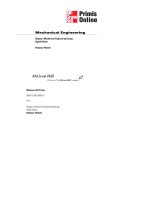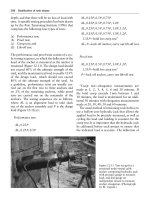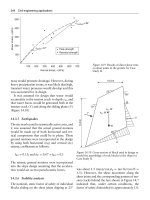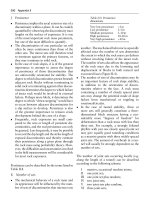Engineering design 4th edition
Bạn đang xem bản rút gọn của tài liệu. Xem và tải ngay bản đầy đủ của tài liệu tại đây (10.89 MB, 971 trang )
ROADMAP to ENGINEERING DESIGN
3
4
5
6
7
Define
problem
Gather
information
Concept
generation
Evaluate &
select concept
Problem statement
Benchmarking
Product dissection
House of Quality
PDS
Internet
Patents
Technical articles
Trade journals
Consultants
Creativity methods
Brainstorming
Functional models
Decomposition
Systematic design
methods
Decision making
Selection criteria
Pugh chart
Decision matrix
AHP
Conceptual design
8
10
Product
architecture
11
12
13
13
Configuration
design
Preliminary
selection of
materials and
manufacturing
processes
Modeling
Sizing of parts
Arrangement of
physical elements
Modularity
8
Embodiment design
Chap.1 – The Engineering Design Process
Chap.2 – The Product Development Process
Chap.3 – Problem Definition and Need
Identification
Chap.4 – Team Behavior and Tools
Chap.5 – Gathering Information
Chap.6 – Concept Generation
Chap.7 – Decision Making and Concept
Selection
Chap.8 – Embodiment Design
Chap.9 – Detail Design
Chap.10 – Modeling and Simulation
die37039_ch98_ifc.indd 1
14
15
16
9
16
Parametric
design
Detail
design
Robust design
Set tolerances
DFM, DFA, DFE
Tolerances
Engineering
drawings
Finalize PDS
11 12
Chap.11 – Materials Selection
Chap.12 – Design with Materials
Chap.13 – Design for Manufacturing
Chap.14 – Risk, Reliability, and Safety
Chap.15 – Quality, Robust Design,
and Optimization
Chap.16 – Cost Evaluation
Chap.17 – Legal and Ethical Issues in
Engineering Design*
Chap.18 – Economic Decision
Making*
*see www.mhhe.com/dieter
2/25/08 7:07:02 PM
ENGI N EER I NG DESIGN
die37039_ch00_fm.indd i
2/25/08 6:50:01 PM
die37039_ch00_fm.indd ii
2/25/08 6:50:01 PM
ENGINEERING DESIGN
FOURTH EDITION
George E. Dieter
University of Maryland
Linda C. Schmidt
University of Maryland
die37039_ch00_fm.indd iii
2/25/08 6:50:01 PM
ENGINEERING DESIGN, FOURTH EDITION
Published by McGraw-Hill, a business unit of The McGraw-Hill Companies, Inc., 1221 Avenue of the
Americas, New York, NY 10020. Copyright © 2009 by The McGraw-Hill Companies, Inc. All rights
reserved. Previous editions © 2000, 1991, 1983. No part of this publication may be reproduced or
distributed in any form or by any means, or stored in a database or retrieval system, without the prior
written consent of The McGraw-Hill Companies, Inc., including, but not limited to, in any network or
other electronic storage or transmission, or broadcast for distance learning.
Some ancillaries, including electronic and print components, may not be available to customers outside
the United States.
This book is printed on acid-free paper.
1 2 3 4 5 6 7 8 9 0 DOC/DOC 0 9 8
ISBN 978–0–07–283703–2
MHID 0–07–283703–9
Global Publisher: Raghothaman Srinivasan
Senior Sponsoring Editor: Bill Stenquist
Director of Development: Kristine Tibbetts
Developmental Editor: Lorraine K. Buczek
Senior Project Manager: Kay J. Brimeyer
Senior Production Supervisor: Laura Fuller
Associate Design Coordinator: Brenda A. Rolwes
Cover Designer: Studio Montage, St. Louis, Missouri
Cover Illustration: Paul Turnbaugh
(USE) Cover Image: Group of Students: © 2007, Al Santos, Photographer; Vacuum Roller: © Brian C.
Grubel; Machinery: © John A. Rizzo/Getty Images; Gears and Machinery: © Nick Koudis/Getty
Images; University Students Using Library Computers: BananaStock/ Jupiter Images
Compositor: Newgen
Typeface: 10.5/12 Times Roman
Printer: R. R. Donnelley Crawfordsville, IN
Library of Congress Cataloging-in-Publication Data
Dieter, George Ellwood.
Engineering design / George E. Dieter, Linda C. Schmidt. — 4th ed.
p. cm.
Includes bibliographical references and indexes.
ISBN 978-0-07-283703-2 — ISBN 0-07-283703-9 (hard copy : alk. paper)
1. Engineering design. I. Schmidt, Linda C. II. Title.
TA174.D495 2009
620Ј.0042—dc22
2007049735
www.mhhe.com
die37039_ch00_fm.indd iv
2/25/08 6:50:02 PM
ABOUT THE AUTHORS
G E O R G E E . D I E T E R is Glenn L. Martin Institute Professor of Engineering at
the University of Maryland. The author received his B.S. Met.E. degree from Drexel
University and his D.Sc. degree from Carnegie Mellon University. After a stint in
industry with the DuPont Engineering Research Laboratory, he became head of the
Metallurgical Engineering Department at Drexel University, where he later became
Dean of Engineering. Professor Dieter later joined the faculty of Carnegie Mellon
University as Professor of Engineering and Director of the Processing Research Institute. He moved to the University of Maryland in 1977 as professor of Mechanical
Engineering and Dean of Engineering, serving as dean until 1994.
Professor Dieter is a fellow of ASM International, TMS, AAAS, and ASEE. He
has received the education award from ASM, TMS, and SME, as well as the Lamme
Medal, the highest award of ASEE. He has been chair of the Engineering Deans
Council, and president of ASEE. He is a member of the National Academy of Engineering. He also is the author of Mechanical Metallurgy, published by McGraw-Hill,
now in its third edition.
L I N DA C . S C H M I D T is an Associate Professor in the Department of Mechanical Engineering at the University of Maryland. Dr. Schmidt’s general research interests and publications are in the areas of mechanical design theory and methodology,
design generation systems for use during conceptual design, design rationale capture,
and effective student learning on engineering project design teams.
Dr. Schmidt completed her doctorate in Mechanical Engineering at Carnegie
Mellon University with research in grammar-based generative design. She holds B.S.
and M.S. degrees from Iowa State University for work in Industrial Engineering.
Dr. Schmidt is a recipient of the 1998 U.S. National Science Foundation Faculty Early
Career Award for generative conceptual design. She co-founded RISE, a summer
research experience that won the 2003 Exemplary Program Award from the American College Personnel Association’s Commission for Academic Support in Higher
Education.
die37039_ch00_fm.indd v
2/25/08 6:50:02 PM
vi
engineer ing design
Dr. Schmidt is active in engineering design theory research and teaching engineering design to third- and fourth-year undergraduates and graduate students in
mechanical engineering. She has coauthored a text on engineering decision-making,
two editions of a text on product development, and a team-training curriculum for
faculty using engineering student project teams. Dr. Schmidt was the guest editor of
the Journal of Engineering Valuation & Cost Analysis and has served as an Associate Editor of the ASME Journal of Mechanical Design. Dr. Schmidt is a member of
ASME, SME, and ASEE.
die37039_ch00_fm.indd vi
2/25/08 6:50:03 PM
BRIEF CONTENTS
Chapter 1
Chapter 2
Chapter 3
Chapter 4
Chapter 5
Chapter 6
Chapter 7
Chapter 8
Chapter 9
Chapter 10
Chapter 11
Chapter 12
Chapter 13
Chapter 14
Chapter 15
Chapter 16
Chapter 17
Chapter 18
Engineering Design
Product Development Process
Problem Definition and Need Identification
Team Behavior and Tools
Gathering Information
Concept Generation
Decision Making and Concept Selection
Embodiment Design
Detail Design
Modeling and Simulation
Materials Selection
Design with Materials
Design for Manufacturing
Risk, Reliability, and Safety
Quality, Robust Design, and Optimization
Cost Evaluation
Legal and Ethical Issues in Engineering Design
Economic Decision Making
1
39
75
116
158
196
262
298
386
411
457
515
558
669
723
779
828
858
Appendices
Author & Subject Indexes
A-1
I-1
vii
die37039_ch00_fm.indd vii
2/25/08 6:50:03 PM
DETAILED CONTENTS
Preface
Chapter 1
xxiii
Engineering Design
1.1
1.2
1.3
1.4
1.5
1.6
1.7
1.8
1
Introduction
Engineering Design Process
1.2.1 Importance of the Engineering Design Process
1.2.2 Types of Designs
Ways to Think About the Engineering Design Process
1.3.1 A Simplified Iteration Model
1.3.2 Design Method Versus Scientific Method
1.3.3 A Problem-Solving Methodology
Considerations of a Good Design
1.4.1 Achievement of Performance Requirements
1.4.2 Total Life Cycle
1.4.3 Regulatory and Social Issues
Description of Design Process
1.5.1 Phase I. Conceptual Design
1.5.2 Phase II. Embodiment Design
1.5.3 Phase III. Detail Design
1.5.4 Phase IV. Planning for Manufacture
1.5.5 Phase V. Planning for Distribution
1.5.6 Phase VI. Planning for Use
1.5.7 Phase VII. Planning for Retirement of the
Product
Computer-Aided Engineering
Designing to Codes and Standards
Design Review
1.8.1 Redesign
1.9
Societal Considerations in Engineering Design
1
3
4
5
6
6
8
10
14
14
17
18
19
19
20
21
22
23
23
23
24
26
29
30
31
viii
die37039_ch00_fm.indd viii
2/25/08 6:50:03 PM
detailed contents
1.10
Chapter 2
Product Development Process
2.1
2.2
2.3
2.4
2.5
2.6
2.7
Chapter 3
Introduction
Product Development Process
2.2.1 Factors for Success
2.2.2 Static Versus Dynamic Products
2.2.3 Variations on the Generic Product Development
Process
Product and Process Cycles
2.3.1 Stages of Development of a Product
2.3.2 Technology Development and Insertion Cycle
2.3.3 Process Development Cycle
Organization for Design and Product Development
2.4.1 A Typical Organization by Functions
2.4.2 Organization by Projects
2.4.3 Hybrid Organizations
2.4.4 Concurrent Engineering Teams
Markets and Marketing
2.5.1 Markets
2.5.2 Market Segmentation
2.5.3 Functions of a Marketing Department
2.5.4 Elements of a Marketing Plan
Technological Innovation
2.6.1 Invention, Innovation, and Diffusion
2.6.2 Business Strategies Related to Innovation and
Product Development
2.6.3 Characteristics of Innovative People
2.6.4 Types of Technology Innovation
Summary
New Terms and Concepts
Bibliography
Problems and Exercises
Problem Definition and Need Identification
3.1
3.2
3.3
die37039_ch00_fm.indd ix
Summary
New Terms and Concepts
Bibliography
Problems and Exercises
Introduction
Identifying Customer Needs
3.2.1 Preliminary Research on Customers Needs
3.2.2 Gathering Information from Customers
Customer Requirements
3.3.1 Differing Views of Customer Requirements
3.3.2 Classifying Customer Requirements
ix
35
36
37
37
39
39
39
43
46
46
47
47
48
50
51
53
54
55
57
58
59
60
63
63
64
64
67
68
69
71
72
72
73
75
75
77
79
80
86
87
89
2/25/08 6:50:03 PM
x
engineer ing design
3.4
3.5
3.6
3.7
Chapter 4
Team Behavior and Tools
4.1
4.2
4.3
4.4
4.5
4.6
4.7
4.8
4.9
4.10
Chapter 5
Introduction
What It Means to be an Effective Team Member
Team Roles
Team Dynamics
Effective Team Meetings
4.5.1 Helpful Rules for Meeting Success
Problems with Teams
Problem-Solving Tools
4.7.1 Applying the Problem-Solving Tools in Design
Time Management
Planning and Scheduling
4.9.1 Work Breakdown Structure
4.9.2 Gantt Chart
4.9.3 Critical Path Method
Summary
New Terms and Concepts
Bibliography
Problems and Exercises
Gathering Information
5.1
5.2
5.3
5.4
die37039_ch00_fm.indd x
Establishing the Engineering Characteristics
3.4.1 Benchmarking in General
3.4.2 Competitive Performance Benchmarking
3.4.3 Reverse Engineering or Product Dissection
3.4.4 Determining Engineering Characteristics
Quality Function Deployment
3.5.1 The House of Quality Configurations
3.5.2 Steps for Building a House of Quality
3.5.3 Interpreting Results of HOQ
Product Design Specification
Summary
Bibliography
New Terms and Concepts
Problems and Exercises
The Information Challenge
5.1.1 Your Information Plan
5.1.2 Data, Information, and Knowledge
Types of Design Information
Sources of Design Information
Library Sources of Information
5.4.1 Dictionaries and Encyclopedias
5.4.2 Handbooks
5.4.3 Textbooks and Monographs
91
93
95
96
97
98
100
102
107
109
111
113
114
114
116
116
117
118
119
122
123
124
126
140
145
146
147
147
149
154
155
155
156
158
158
159
160
162
162
166
167
169
169
2/25/08 6:50:03 PM
detailed contents
5.5
5.6
5.7
5.8
5.9
5.10
5.11
Chapter 6
Concept Generation
6.1
6.2
6.3
6.4
6.5
die37039_ch00_fm.indd xi
5.4.4 Finding Periodicals
5.4.5 Catalogs, Brochures, and Business Information
Government Sources of Information
Information From the Internet
5.6.1 Searching with Google
5.6.2 Some Helpful URLs for Design
5.6.3 Business-Related URLs for Design and
Product Development
Professional Societies and Trade Associations
Codes and Standards
Patents and Other Intellectual Property
5.9.1 Intellectual Property
5.9.2 The Patent System
5.9.3 Technology Licensing
5.9.4 The Patent Literature
5.9.5 Reading a Patent
5.9.6 Copyrights
Company-Centered Information
Summary
New Terms and Concepts
Bibliography
Problems and Exercises
Introduction to Creative Thinking
6.1.1 Models of the Brain and Creativity
6.1.2 Thinking Processes that Lead to Creative Ideas
Creativity and Problem Solving
6.2.1 Aids to Creative Thinking
6.2.2 Barriers to Creative Thinking
Creative Thinking Methods
6.3.1 Brainstorming
6.3.2 Idea Generating Techniques Beyond Brainstorming
6.3.3 Random Input Technique
6.3.4 Synectics: An Inventive Method Based on
Analogy
6.3.5 Concept Map
Creative Methods for Design
6.4.1 Refinement and Evaluation of Ideas
6.4.2 Generating Design Concepts
6.4.3 Systematic Methods for Designing
Functional Decomposition and Synthesis
6.5.1 Physical Decomposition
6.5.2 Functional Representation
6.5.3 Performing Functional Decomposition
6.5.4 Strengths and Weaknesses of Functional Synthesis
xi
169
171
171
172
174
176
178
180
181
183
184
185
187
187
189
191
192
193
194
194
194
196
197
197
201
202
202
205
208
208
210
212
213
215
217
217
219
221
222
223
225
229
232
2/25/08 6:50:04 PM
xii
engineer ing design
6.6
6.7
6.8
6.9
Chapter 7
Decision Making and Concept Selection
7.1
7.2
7.3
7.4
Chapter 8
Introduction
Decision Making
7.2.1 Behavioral Aspects of Decision Making
7.2.2 Decision Theory
7.2.3 Utility Theory
7.2.4 Decision Trees
Evaluation Methods
7.3.1 Comparison Based on Absolute Criteria
7.3.2 Pugh Concept Selection Method
7.3.3 Measurement Scales
7.3.4 Weighted Decision Matrix
7.3.5 Analytic Hierarchy Process (AHP)
Summary
New Terms and Concepts
Bibliography
Problems and Exercises
Embodiment Design
8.1
die37039_ch00_fm.indd xii
Morphological Methods
6.6.1 Morphological Method for Design
6.6.2 Generating Concepts from Morphological Chart
TRIZ: The Theory of Inventive Problem Solving
6.7.1 Invention: Evolution to Increased Ideality
6.7.2 Innovation by Overcoming Contradictions
6.7.3 TRIZ Inventive Principles
6.7.4 The TRIZ Contradiction Matrix
6.7.5 Strengths and Weaknesses of TRIZ
Axiomatic Design
6.8.1 Axiomatic Design Introduction
6.8.2 The Axioms
6.8.3 Using Axiomatic Design to Generate a Concept
6.8.4 Using Axiomatic Design to Improve an
Existing Concept
6.8.5 Strengths and Weaknesses of Axiomatic Design
Summary
New Terms and Concepts
Bibliography
Problems and Exercises
Introduction
8.1.1 Comments on Nomenclature Concerning
the Phases of the Design Process
8.1.2 Oversimplification of the Design Process Model
233
234
236
237
238
239
240
243
247
249
249
250
251
253
257
258
259
260
260
262
262
263
263
266
269
273
274
275
277
280
282
285
292
294
294
294
298
298
299
300
2/25/08 6:50:04 PM
detailed contents
8.2
8.3
8.4
8.5
8.6
8.7
8.8
8.9
8.10
die37039_ch00_fm.indd xiii
Product Architecture
8.2.1 Types of Modular Architectures
8.2.2 Modularity and Mass Customization
8.2.3 Create the Schematic Diagram of the Product
8.2.4 Cluster the Elements of the Schematic
8.2.5 Create a Rough Geometric Layout
8.2.6 Define Interactions and Determine Performance
Characteristics
Configuration Design
8.3.1 Generating Alternative Configurations
8.3.2 Analyzing Configuration Designs
8.3.3 Evaluating Configuration Designs
Best Practices for Configuration Design
8.4.1 Design Guidelines
8.4.2 Interfaces and Connections
8.4.3 Checklist for Configuration Design
8.4.4 Design Catalogs
Parametric Design
8.5.1 Systematic Steps in Parametric Design
8.5.2 A Parametric Design Example: Helical Coil
Compression Spring
8.5.3 Design for Manufacture (DFM) and Design for
Assembly (DFA)
8.5.4 Failure Modes and Effects Analysis (FMEA)
8.5.5 Design for Reliability and Safety
8.5.6 Design for Quality and Robustness
Dimensions and Tolerances
8.6.1 Dimensions
8.6.2 Tolerances
8.6.3 Geometric Dimensioning and Tolerancing
8.6.4 Guidelines for Tolerance Design
Industrial Design
8.7.1 Visual Aesthetics
Human Factors Design
8.8.1 Human Physical Effort
8.8.2 Sensory Input
8.8.3 Anthropometric Data
8.8.4 Design for Serviceability
Design for the Environment
8.9.1 Life Cycle Design
8.9.2 Design for the Environment (DFE)
8.9.3 DFE Scoring Methods
Prototyping and Testing
8.10.1 Prototype and Model Testing Throughout the
Design Process
8.10.2 Building Prototypes
xiii
301
303
303
305
306
307
308
309
312
315
315
316
317
321
324
325
325
326
328
336
337
337
338
338
339
340
350
355
356
357
358
359
361
364
364
365
366
368
370
370
371
372
2/25/08 6:50:04 PM
xiv
engineer ing design
8.11
8.12
Chapter 9
Detail Design
9.1
9.2
9.3
9.4
9.5
9.6
9.7
Chapter 10
Introduction
Activities and Decisions in Detail Design
Communicating Design and Manufacturing Information
9.3.1 Engineering Drawings
9.3.2 Bill of Materials
9.3.3 Written Documents
9.3.4 Common Challenges in Technical Writing
9.3.5 Meetings
9.3.6 Oral Presentations
Final Design Review
9.4.1 Input Documents
9.4.2 Review Meeting Process
9.4.3 Output from Review
Design and Business Activities Beyond Detail Design
Facilitating Design and Manufacturing with
Computer-Based Methods
9.6.1 Product Lifecycle Management (PLM)
Summary
New Terms and Concepts
Bibliography
Problems and Exercises
373
374
377
378
380
382
382
383
383
386
386
387
391
391
394
395
398
399
400
402
402
403
403
403
406
407
408
408
409
409
Modeling and Simulation
411
10.1
411
412
413
414
414
423
425
429
432
434
435
439
10.2
10.3
10.4
10.5
10.6
die37039_ch00_fm.indd xiv
8.10.3 Rapid Prototyping
8.10.4 RP Processes
8.10.5 Testing
8.10.6 Statistical Design of Testing
Design for X (DFX)
Summary
New Terms and Concepts
Bibliography
Problems and Exercises
The Role of Models in Engineering Design
10.1.1 Types of Models
10.1.2 Iconic, Analog, and Symbolic Models
Mathematical Modeling
10.2.1 The Model-Building Process
Dimensional Analysis
10.3.1 Similitude and Scale Models
Finite-Difference Method
Geometric Modeling on the Computer
Finite Element Analysis
10.6.1 The Concept Behind FEA
10.6.2 Types of Elements
2/25/08 6:50:04 PM
detailed contents
10.7
10.8
Chapter 11
10.6.3 Steps in the FEA Process
10.6.4 Current Practice
Simulation
10.7.1 Introduction to Simulation Modeling
10.7.2 Simulation Programming Software
10.7.3 Monte Carlo Simulation
Summary
New Terms and Concepts
Bibliography
Problems and Exercises
442
444
446
446
447
449
452
453
454
454
Materials Selection
457
11.1
457
458
460
460
461
462
463
470
471
472
474
476
476
478
479
479
482
482
482
485
486
487
488
489
494
495
496
499
503
504
504
506
508
Introduction
11.1.1 Relation of Materials Selection to Design
11.1.2 General Criteria for Selection
11.1.3 Overview of the Materials Selection Process
11.2 Performance Characteristics of Materials
11.2.1 Classification of Materials
11.2.2 Properties of Materials
11.2.3 Specification of Materials
11.2.4 Ashby Charts
11.3 The Materials Selection Process
11.3.1 Design Process and Materials Selection
11.3.2 Materials Selection in Conceptual Design
11.3.3 Materials Selection in Embodiment Design
11.4 Sources of Information on Materials Properties
11.4.1 Conceptual Design
11.4.2 Embodiment Design
11.4.3 Detail Design
11.5 Economics of Materials
11.5.1 Cost of Materials
11.5.2 Cost Structure of Materials
11.6 Overview of Methods of Materials Selection
11.7 Selection with Computer-Aided Databases
11.8 Material Performance Indices
11.8.1 Material Performance Index
11.9 Materials Selection with Decision Matrices
11.9.1 Pugh Selection Method
11.9.2 Weighted Property Index
11.10 Design Examples
11.11 Recycling and Materials Selection
11.11.1 Benefits from Recycling
11.11.2 Steps in Recycling
11.11.3 Design for Recycling
11.11.4 Material Selection for Eco-attributes
die37039_ch00_fm.indd xv
xv
2/25/08 6:50:05 PM
xvi
engineer ing design
11.12 Summary
New Terms and Concepts
Bibliography
Problems and Exercises
Chapter 12
Design with Materials
515
12.1
12.2
515
516
518
522
523
524
525
528
529
531
536
538
539
539
541
544
544
546
547
549
549
552
553
555
556
556
556
12.3
12.4
12.5
12.6
12.7
Chapter 13
Introduction
Design for Brittle Fracture
12.2.1 Plane Strain Fracture Toughness
12.2.2 Limitations on Fracture Mechanics
Design for Fatigue Failure
12.3.1 Fatigue Design Criteria
12.3.2 Fatigue Parameters
12.3.3 Information Sources on Design for Fatigue
12.3.4 Infinite Life Design
12.3.5 Safe-Life Design Strategy
12.3.6 Damage-Tolerant Design Strategy
12.3.7 Further Issues in Fatigue Life Prediction
Design for Corrosion Resistance
12.4.1 Basic Forms of Corrosion
12.4.2 Corrosion Prevention
Design Against Wear
12.5.1 Types of Wear
12.5.2 Wear Models
12.5.3 Wear Prevention
Design with Plastics
12.6.1 Classification of Plastics and Their Properties
12.6.2 Design for Stiffness
12.6.3 Time-Dependent Part Performance
Summary
New Terms and Concepts
Bibliography
Problems and Exercises
Design for Manufacturing
13.1
13.2
13.3
13.4
die37039_ch00_fm.indd xvi
510
511
512
512
Role of Manufacturing in Design
Manufacturing Functions
Classification of Manufacturing Processes
13.3.1 Types of Manufacturing Processes
13.3.2 Brief Description of the Classes of Manufacturing
Processes
13.3.3 Sources of Information on Manufacturing
Processes
13.3.4 Types of Manufacturing Systems
Manufacturing Process Selection
13.4.1 Quantity of Parts Required
13.4.2 Shape and Feature Complexity
558
558
560
562
563
564
565
565
568
569
573
2/25/08 6:50:05 PM
detailed contents
13.5
13.6
13.7
13.8
13.9
13.10
13.11
13.12
13.13
13.14
13.15
13.16
die37039_ch00_fm.indd xvii
13.4.3 Size
13.4.4 Influence of Material on Process Selection
13.4.5 Required Quality of the Part
13.4.6 Cost to Manufacture
13.4.7 Availability, Lead Time, and Delivery
13.4.8 Further Information for Process Selection
Design for Manufacture (DFM)
13.5.1 DFM Guidelines
13.5.2 Specific Design Rules
Design for Assembly (DFA)
13.6.1 DFA Guidelines
Role of Standardization in DFMA
13.7.1 Benefits of Standardization
13.7.2 Achieving Part Standardization
13.7.3 Group Technology
Mistake-Proofing
13.8.1 Using Inspection to Find Mistakes
13.8.2 Frequent Mistakes
13.8.3 Mistake-Proofing Process
13.8.4 Mistake-Proofing Solutions
Early Estimation of Manufacturing Cost
Computer Methods for DFMA
13.10.1 DFA Analysis
13.10.2 Concurrent Costing with DFM
13.10.3 Process Modeling and Simulation
Design of Castings
13.11.1 Guidelines for the Design of Castings
13.11.2 Producing Quality Castings
Design of Forgings
13.12.1 DFM Guidelines for Closed-Die Forging
13.12.2 Computer-Aided Forging Design
Design for Sheet-Metal Forming
13.13.1 Sheet Metal Stamping
13.13.2 Sheet Bending
13.13.3 Stretching and Deep Drawing
13.13.4 Computer-Aided Sheet Metal Design
Design of Machining
13.14.1 Machinability
13.14.2 DFM Guidelines for Machining
Design of Welding
13.15.1 Joining Processes
13.15.2 Welding Processes
13.15.3 Welding Design
13.15.4 Cost of Joining
Residual Stresses in Design
13.16.1 Origin of Residual Stresses
13.16.2 Residual Stress Created by Quenching
xvii
576
577
579
583
586
586
593
594
597
597
598
601
601
603
603
606
606
607
608
609
610
617
617
620
624
624
626
627
629
631
632
633
633
634
635
637
637
640
640
643
643
643
646
649
650
650
652
2/25/08 6:50:05 PM
xviii
Chapter 14
engineer ing design
13.16.3 Other Issues Regarding Residual Stresses
13.16.4 Relief of Residual Stresses
13.17 Design for Heat Treatment
13.17.1 Issues with Heat Treatment
13.17.2 DFM for Heat Treatment
13.18 Design for Plastics Processing
13.18.1 Injection Molding
13.18.2 Extrusion
13.18.3 Blow Molding
13.18.4 Rotational Molding
13.18.5 Thermoforming
13.18.6 Compression Molding
13.18.7 Casting
13.18.8 Composite Processing
13.18.9 DFM Guidelines for Plastics Processing
13.19 Summary
New Terms and Concepts
Bibliography
Problems and Exercises
654
656
656
657
658
659
659
660
661
661
661
661
662
662
663
664
666
666
666
Risk, Reliability, and Safety
669
14.1
14.2
14.3
14.4
die37039_ch00_fm.indd xviii
Introduction
14.1.1 Regulation as a Result of Risk
14.1.2 Standards
14.1.3 Risk Assessment
Probabilistic Approach to Design
14.2.1 Basic Probability Using the Normal Distribution
14.2.2 Sources of Statistical Tables
14.2.3 Frequency Distributions Combining Applied
Stress and Material Strength
14.2.4 Variability in Material Properties
14.2.5 Probabilistic Design
14.2.6 Safety Factor
14.2.7 Worst-Case Design
Reliability Theory
14.3.1 Definitions
14.3.2 Constant Failure Rate
14.3.3 Weibull Frequency Distribution
14.3.4 Reliability with a Variable Failure Rate
14.3.5 System Reliability
14.3.6 Maintenance and Repair
14.3.7 Further Topics
Design for Reliability
14.4.1 Causes of Unreliability
14.4.2 Minimizing Failure
14.4.3 Sources of Reliability Data
14.4.4 Cost of Reliability
669
671
672
673
674
675
677
677
679
682
684
685
685
688
688
690
692
696
699
700
701
703
703
706
706
2/25/08 6:50:05 PM
14.5
14.6
14.7
14.8
Chapter 15
xix
Failure Mode and Effects Analysis (FMEA)
14.5.1 Making a FMEA Analysis
Defects and Failure Modes
14.7.1 Causes of Hardware Failure
14.7.2 Failure Modes
14.7.3 Importance of Failure
Design for Safety
14.9.1 Potential Dangers
14.9.2 Guidelines for Design for Safety
14.9.3 Warning Labels
Summary
New Terms and Concepts
Bibliography
Problems and Exercises
707
710
712
713
713
715
715
716
717
718
718
719
719
720
Quality, Robust Design, and Optimization
15.1
15.2
15.3
15.4
15.5
15.6
15.7
15.8
die37039_ch00_fm.indd xix
detailed contents
The Concept of Total Quality
15.1.1 Definition of Quality
15.1.2 Deming’s 14 Points
Quality Control and Assurance
15.2.1 Fitness for Use
15.2.2 Quality-Control Concepts
15.2.3 Newer Approaches to Quality Control
15.2.4 Quality Assurance
15.2.5 ISO 9000
Quality Improvement
15.3.1 Pareto chart
15.3.2 Cause-and-Effect Diagram
Process Capability
15.4.1 Six Sigma Quality Program
Statistical Process Control
15.5.1 Control Charts
15.5.2 Other Types of Control Charts
15.5.3 Determining Process Statistics from
Control Charts
Taguchi Method
15.6.1 Loss Function
15.6.2 Noise Factors
15.6.3 Signal-to-Noise Ratio
Robust Design
15.7.1 Parameter Design
15.7.2 Tolerance Design
Optimization Methods
15.8.1 Optimization by Differential Calculus
15.8.2 Search Methods
15.8.3 Nonlinear Optimization Methods
15.8.4 Other Optimization Methods
723
723
724
725
726
726
727
729
729
730
730
731
732
734
738
739
739
742
743
743
744
747
748
749
749
755
755
758
762
767
770
2/25/08 6:50:05 PM
xx
engineer ing design
15.9 Design Optimization
15.10 Summary
New Terms and Concepts
Bibliography
Problems and Exercises
Chapter 16
Cost Evaluation
779
16.1
16.2
16.3
16.4
16.5
779
780
784
787
789
790
790
791
795
796
797
801
802
802
803
805
808
809
809
811
814
814
818
822
823
823
823
16.6
16.7
16.8
16.9
16.10
16.11
16.12
16.13
16.14
Chapter 17
Introduction
Categories of Costs
Overhead Cost
Activity-Based Costing
Methods of Developing Cost Estimates
16.5.1 Analogy
16.5.2 Parametric and Factor Methods
16.5.3 Detailed Methods Costing
Make-Buy Decision
Manufacturing Cost
Product Profit Model
16.8.1 Profit Improvement
Refinements to Cost Analysis Methods
16.9.1 Cost Indexes
16.9.2 Cost-Size Relationships
16.9.3 Learning Curve
Design to Cost
16.10.1 Order of Magnitude Estimates
16.10.2 Costing in Conceptual Design
Value Analysis in Costing
Manufacturing Cost Models
16.12.1 Machining Cost Model
Life Cycle Costing
Summary
New Terms and Concepts
Bibliography
Problems and Exercises
Legal and Ethical Issues in Engineering Design
(see www.mhhe.com/dieter)
17.1 Introduction
17.2 The Origin of Laws
17.3 Contracts
17.3.1 Types of Contracts
17.3.2 General Form of a Contract
17.3.3 Discharge and Breach of Contract
17.4 Liability
17.5 Tort Law
die37039_ch00_fm.indd xx
772
774
775
775
775
828
828
829
830
830
831
832
833
834
2/25/08 6:50:06 PM
detailed contents
xxi
Product Liability
17.6.1 Evolution of Product Liability Law
17.6.2 Goals of Product Liability Law
17.6.3 Negligence
17.6.4 Strict Liability
17.6.5 Design Aspect of Product Liability
17.6.6 Business Procedures to Minimize Risk of
Product Liability
17.6.7 Problems with Product Liability Law
17.7 Protecting Intellectual Property
17.8 The Legal and Ethical Domains
17.9 Codes of Ethics
17.9.1 Profession of Engineering
17.9.2 Codes of Ethics
17.9.3 Extremes of Ethical Behavior
17.10 Solving Ethical Conflicts
17.10.1 Whistleblowing
17.10.2 Case Studies
17.11 Summary
New Terms and Concepts
Bibliography
Problems and Exercises
835
836
836
837
837
838
839
839
840
841
843
844
844
848
848
850
851
852
854
854
855
Economic Decision Making (see www.mhhe.com/dieter)
858
17.6
Chapter 18
18.1
18.2
18.3
18.4
18.5
18.6
die37039_ch00_fm.indd xxi
Introduction
Mathematics of Time Value of Money
18.2.1 Compound Interest
18.2.2 Cash Flow Diagram
18.2.3 Uniform Annual Series
18.2.4 Irregular Cash Flows
Cost Comparison
18.3.1 Present Worth Analysis
18.3.2 Annual Cost Analysis
18.3.3 Capitalized Cost Analysis
18.3.4 Using Excel Functions for Engineering
Economy Calculation
Depreciation
18.4.1 Straight-Line Depreciation
18.4.2 Declining-Balance Depreciation
18.4.3 Sum-of-Years-Digits Depreciation
18.4.4 Modified Accelerated Cost Recovery
System (MACRS)
Taxes
Profitability Of Investments
18.6.1 Rate of Return
18.6.2 Payback Period
858
859
859
861
862
865
867
867
869
870
872
872
873
874
874
874
876
880
880
882
2/25/08 6:50:06 PM
xxii
die37039_ch00_fm.indd xxii
engineer ing design
18.6.3 Net Present Worth
18.6.4 Internal Rate of Return
18.7 Other Aspects of Profitability
18.8 Inflation
18.9 Sensitivity and Break-Even Analysis
18.10 Uncertainty in Economic Analysis
18.11 Benefit-Cost Analysis
18.12 Summary
New Terms and Concepts
Bibliography
Problems and Exercises
882
883
887
888
891
892
894
896
898
898
898
Appendices
Author & Subject Indexes
A-1
I-1
2/25/08 6:50:06 PM
PREFACE TO FOURTH EDITION
T h e f o u r t h e d i t i o n of Engineering Design represents the reorganization and
expansion of the topics and the introduction of a coauthor, Dr. Linda Schmidt of the
Mechanical Engineering Department, University of Maryland. As in previous editions,
Engineering Design is intended to provide a realistic understanding of the engineering design process. It is broader in content than most design texts, but it now contains
more prescriptive guidance on how to carry out design. The text is intended to be used
in either a junior or senior engineering course with an integrated hands-on design
project. The design process material is presented in a sequential format in Chapters 1
through 9. At the University of Maryland we use Chapters 1 through 9 with junior
students in a course introducing the design process. Chapters 10 through 17 present
more intense treatment of sophisticated design content, including materials selection,
design for manufacturing, and quality. The complete text is used in the senior capstone
design course that includes a complete design project from selecting a market to creating a working prototype. Students move quickly through the first nine chapters and
emphasize chapters 10 through 17 for making embodiment design decisions.
The authors recognize deterrents to learning the design process. Design is a
complex process to teach in a short amount of time. Students are aware of a myriad of design texts and tools and become overwhelmed with the breadth of design
approaches. One challenge of the design instructor’s task is to convey to the student
that engineering design is not a mathematical equation to be solved or optimized.
Another is to provide students with a cohesive structure for the design process that
they can use with a variety of design methods and software packages. Toward that
end, we have adopted a uniform terminology throughout and reinforced this with a
new section at the end of each chapter on New Terms and Concepts. We have emphasized a cohesive eight-step engineering design process and present all material in the
context of how it is applied. Regardless, we are strong in the belief that to learn design
you must do design. We have found that Chapter 4, Team Behavior and Tools, is helpful to the students in this regard. Likewise, we hope that the expanded discussion of
design tools like benchmarking, QFD, creativity methods, functional decomposition
xxiii
die37039_ch00_fm.indd xxiii
2/25/08 6:50:06 PM









